Graph-Symmetry Cognitive Learning for Multi-Scale Cloud Imaging: An Uncertainty-Quantified Geometric Paradigm via Hierarchical Graph Networks
Abstract
1. Introduction
- Prototype-Driven Asymmetric Attention (PDAA). This module uses the K-means algorithm for the dynamic clustering of features and employs an exponential moving average strategy to update cluster centers, thereby better capturing the feature distribution of cloud image data. Additionally, a permutation-invariant intra-group attention mechanism is designed to reduce computational complexity while enhancing the model’s precision in focusing on cloud image features. This innovative design combines a combination clustering algorithm with graph symmetry principles to ensure graph node permutation invariance.
- Symmetry-Adaptive Graph Convolution Layer (SAGCL). This module models cloud image pixels as graph nodes, uses cosine similarity as a semantic distance metric, and constructs a sparse and discriminative graph structure. Symmetrization operations and degree normalization ensure the stability of the graph structure, enabling effective modeling of complex spatial relationships and topological characteristics between cloud layers. This module can further establish feature propagation and global contextual associations across cloud clusters based on the clustering attention mechanism.
- Multi-Scale Directional Edge Refiner (MSDER). Using multi-scale combined convolution decomposition technology, features are extracted and fused from multiple scales to more comprehensively capture cloud map information. Additionally, a gated feature fusion mechanism is designed to dynamically adjust the fusion process based on feature uncertainty, significantly improving the segmentation accuracy of thin fog boundaries and achieving the integration of graph attributes and uncertainty. This design models the complex symmetrical relationships of cloud map features from a graph theory symmetry perspective, enabling intelligent aggregation of multi-scale features and noise suppression.
- Uncertainty-Driven Loss Optimizer (UDLO). This optimizer uses CAM technology to generate activation maps highlighting foreground features, dynamically calculates hit rates for various categories, and uses an exponential decay function to adaptively adjust loss weights. This design enables the model to focus more on rare cloud types that are difficult to identify during training, significantly improving detection rates and enhancing the reliability of the entire network.
2. Related Work
2.1. Advances in Graph Neural Networks for Visual Segmentation
2.2. Symmetric Graph Theory and GNN Applications in Segmentation
2.3. Segmentation Methods Based on U-Net and Its Variants
3. Methods
3.1. Overall Framework
3.2. Prototype-Driven Asymmetric Attention (PDAA)
3.3. Symmetry-Adaptive Graph Convolution Layer (SAGCL)
3.4. Multi-Scale Directional Edge Refiner (MSDER)
3.5. Uncertainty-Driven Loss Optimizer (UDLO)
4. Experiments
4.1. Datasets
4.2. Implementation Details
4.3. Evaluation Metrics
4.4. Comparison Experiments
4.5. Ablation Study
5. Conclusions
Supplementary Materials
Author Contributions
Funding
Data Availability Statement
Conflicts of Interest
References
- Brunet, G.; Parsons, D.B.; Ivanov, D.; Lee, B.; Bauer, P.; Bernier, N.B.; Bouchet, V.; Brown, A.; Busalacchi, A.; Flatter, G.C.; et al. Advancing Weather and Climate Forecasting for Our Changing World. Bull. Amer. Meteor. Soc. 2023, 104, E909–E927. [Google Scholar] [CrossRef]
- Nie, B.; Lu, Z.; Han, J.; Chen, W.; Cai, C.; Pan, W. Investigation on Ground-Based Cloud Image Classification and Its Application in Photovoltaic Power Forecasting. IEEE Trans. Instrum. Meas. 2025, 74, 1–11. [Google Scholar] [CrossRef]
- Xu, Q.; Zhang, Z.; Wang, G.; Chen, Y. Physics-Guided Multi-Representation Learning with Quadruple Consistency Constraints for Robust Cloud Detection in Multi-Platform Remote Sensing. Remote Sens. 2025, 17, 2946. [Google Scholar] [CrossRef]
- Xu, Q.; Zhang, Z.; Wang, G.; Chen, Y. Explainable Multi-Scale CAM Attention for Interpretable Cloud Segmentation in Astro-Meteorological Applications. Appl. Sci. 2025, 15, 8555. [Google Scholar] [CrossRef]
- Li, K.; Ma, N.; Sun, L. Cloud detection of multi-type satellite images based on spectral assimilation and deep learning. Int. J. Remote Sens. 2023, 44, 3106–3121. [Google Scholar] [CrossRef]
- Mohamadzadeh, S.; Ghayedi, M.; Pasban, S.; Shafiei, A.K. Algorithm of Predicting Heart Attack with using Sparse Coder. Int. J. Eng. 2023, 36, 2190–2197. [Google Scholar] [CrossRef]
- Zhang, C.; Weng, L.; Ding, L.; Xia, M.; Lin, H. CRSNet: Cloud and Cloud Shadow Refinement Segmentation Networks for Remote Sensing Imagery. Remote Sens. 2023, 15, 1664. [Google Scholar] [CrossRef]
- Liu, J.; Zhang, Z. Graph Structure Learning Boosted Neural Network for Image Segmentation. In Proceedings of the 2022 18th IEEE International Conference on Advanced Video and Signal Based Surveillance (AVSS), Madrid, Spain, 29 November–2 December 2022; pp. 1–8. [Google Scholar] [CrossRef]
- Pan, C.-H.; Qu, Y.; Yao, Y.; Wang, M.-J.-S. HybridGNN: A Self-Supervised Graph Neural Network for Efficient Maximum Matching in Bipartite Graphs. Symmetry 2024, 16, 1631. [Google Scholar] [CrossRef]
- Kovvuri, S.; Reddy, G.; Saran, B.; Adityaja, A.M.; Shigwan, S.J.; Kumar, N. UnSegGNet: Unsupervised Image Segmentation using Graph Neural Networks. arXiv 2024. [Google Scholar] [CrossRef]
- Kovvuri, R.; Saran, B.; Adityaja, A.; Saurabh, S.; Nitin, K.; Snehasis, K. UnSeGArmaNet: Unsupervised Image Segmentation using Graph Neural Networks with Convolutional ARMA Filters. arXiv 2024. [Google Scholar] [CrossRef]
- Wang, S.; Wang, Y.; Wang, M. Connectivity and matching preclusion for leaf-sort graphs. J. Interconnect. Netw. 2019, 19, 1940007. [Google Scholar] [CrossRef]
- Wang, M.; Xiang, D.; Qu, Y.; Li, G. The diagnosability of interconnection networks. Discret. Appl. Math. 2024, 357, 413–428. [Google Scholar] [CrossRef]
- Wang, M.; Wang, S. Connectivity and diagnosability of center k-ary n-cubes. Discret. Appl. Math. 2021, 294, 98–107. [Google Scholar] [CrossRef]
- Wang, M.-J.; Xiang, D.; Hsieh, S.-Y. G-good-neighbor diagnosability under the modified comparison model for multiprocessor systems. Theor. Comput. Sci. 2025, 1028, 115027. [Google Scholar] [CrossRef]
- Hamilton, W.; Ying, Z.; Leskovec, J. Inductive Representation Learning on Large Graphs. Advances in Neural Information Processing Systems. arXiv 2017. [Google Scholar] [CrossRef]
- Veličković, P.; Cucurull, G.; Casanova, A.; Romero, A.; Lio, P.; Bengio, Y. Graph Attention Networks. In Proceedings of the International Conference on Learning Representations, Vancouver, BC, Canada, 30 April–3 May 2018. [Google Scholar] [CrossRef]
- Ronneberger, O.; Fischer, P.; Brox, T. U-Net: Convolutional Networks for Biomedical Image Segmentation. In Medical Image Computing and Computer-Assisted Intervention—MICCAI 2015. MICCAI 2015; Lecture Notes in Computer Science; Navab, N., Hornegger, J., Wells, W., Frangi, A., Eds.; Springer: Cham, Switzerland, 2015; Volume 9351. [Google Scholar] [CrossRef]
- Oktay, O.; Schlemper, J.; Folgoc, L.L.; Lee, M.J.; Heinrich, M.P.; Misawa, K.; Mori, K.; McDonagh, S.G.; Hammerla, N.Y.; Kainz, B.; et al. Attention U-Net: Learning Where to Look for the Pancreas. arXiv 2018, arXiv:1804.03999. [Google Scholar] [CrossRef]
- Dosovitskiy, A.; Beyer, L.; Kolesnikov, A.; Weissenborn, D.; Zhai, X.; Unterthiner, T.; Dehghani, M.; Minderer, M.; Heigold, G.; Gelly, S.; et al. An image is worth 16 × 16 words: Transformers for image recognition at scale. arXiv 2020, arXiv:2010.11929v2. [Google Scholar] [CrossRef]
- Cao, H.; Wang, Y.; Chen, J.; Jiang, D.; Zhang, X.; Tian, Q.; Wang, M. Swin-Unet: Unet-Like Pure Transformer for Medical Image Segmentation. In Computer Vision—ECCV 2022 Workshops, Proceedings of Part III, Tel Aviv, Israel, 23–27 October 2022; Springer: Berlin, Heidelberg, 2022; pp. 205–218. [Google Scholar] [CrossRef]
- Azad, R.; Kazerouni, A.; Azad, B.; Aghdam, E.K.; Velichko, Y.; Bagci, U.; Merhof, D. Laplacian-Former: Overcoming the Limitations of Vision Transformers in Local Texture Detection. Med. Image Comput. Comput. Assist. Interv. 2023, 14222, 736–746. [Google Scholar] [CrossRef] [PubMed]
- Zhang, L.; Wei, W.; Qiu, B.; Luo, A.; Zhang, M.; Li, X. A Novel Ground-Based Cloud Image Segmentation Method Based on a Multibranch Asymmetric Convolution Module and Attention Mechanism. Remote Sens. 2022, 14, 3970. [Google Scholar] [CrossRef]
- Liu, X.; Gao, P.; Yu, T.; Wang, F.; Yuan, R.-Y. CSWin-UNet: Transformer UNet with cross-shaped windows for medical image segmentation. Inf. Fusion 2025, 113, 102634. [Google Scholar] [CrossRef]
- Liu, Y.; Zhu, H.; Liu, M.; Yu, H.; Chen, Z.; Gao, J. Rolling-Unet: Revitalizing MLP’s Abil-ity to Efficiently Extract Long-Distance Dependencies for Medical Image Segmentation. In Proceedings of the AAAI Conference on Artificial Intelligence, Vancouver, BC, Canada, 20–27 February 2024; pp. 3819–3827. [Google Scholar] [CrossRef]
- Valanarasu, J.M.J.; Oza, P.; Hacihaliloglu, I.; Patel, V.M. Medical Transformer: Gated Axial-Attention for Medical Image Segmentation. In Medical Image Computing and Computer Assisted Intervention—MICCAI 2021; Lecture Notes in Computer Science; de Bruijne, M., Cattin, P.C., Cotin, S., Padoy, N., Speidel, S., Zheng, Y., Essert, C., Eds.; Springer: Cham, Switzerland, 2021; Volume 12901. [Google Scholar] [CrossRef]
- Wang, H.; Wang, Z.; Du, M.; Yang, F.; Zhang, Z.; Ding, S.; Mardziel, P.; Hu, X. Score-CAM: Score-Weighted Visual Explanations for Convolutional Neural Networks. In Proceedings of the IEEE/CVF Conference on Computer Vision and Pattern Recognition Workshops, Seattle, WA, USA, 14–19 June 2020; pp. 24–25. [Google Scholar]
- Selvaraju, R.R.; Cogswell, M.; Das, A.; Vedantam, R.; Parikh, D.; Batra, D. Grad-CAM: Visual Explanations from Deep Networks via Gradient-Based Localization. In Proceedings of the 2017 IEEE International Conference on Computer Vision (ICCV), Venice, Italy, 22–29 October 2017; pp. 618–626. [Google Scholar]
- Dev, S.; Nautiyal, A.; Lee, Y.H.; Winkler, S. CloudSegNet: A Deep Network for Nychthemeron Cloud Image Segmentation. IEEE Geosci. Remote Sens. Lett. 2019, 16, 1814–1818. [Google Scholar] [CrossRef]
- Zhang, Z.; Yang, S.; Liu, S.; Xiao, B.; Cao, X. Ground-Based Cloud Detection Using Multiscale Attention Convolutional Neural Network. IEEE Geosci. Remote Sens. Lett. 2022, 19, 1–5. [Google Scholar] [CrossRef]
- Li, Z.; Shen, H.; Cheng, Q.; Liu, Y.; You, S.; He, Z. Deep learning based cloud detection for medium and high resolution remote sensing images of different sensors. ISPRS J. Photogramm. Remote Sens. 2019, 150, 197–212. [Google Scholar] [CrossRef]
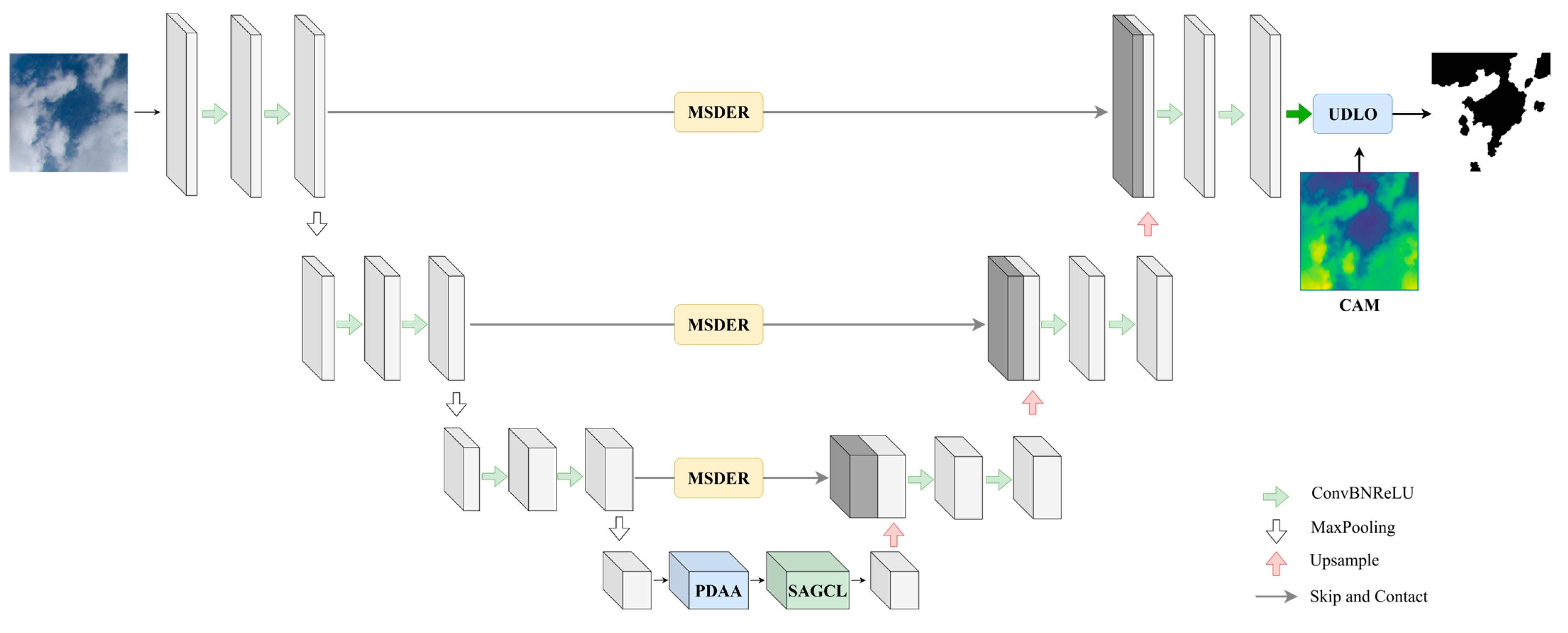
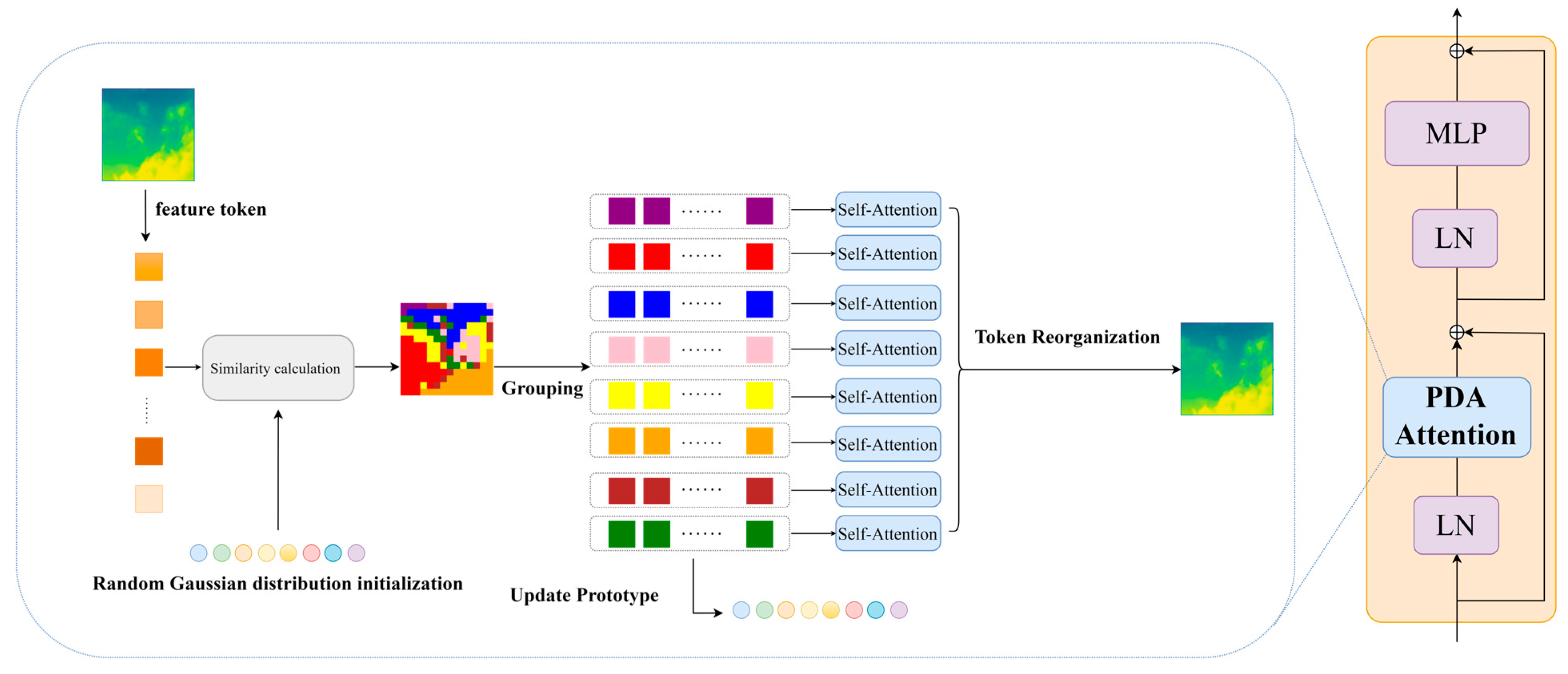
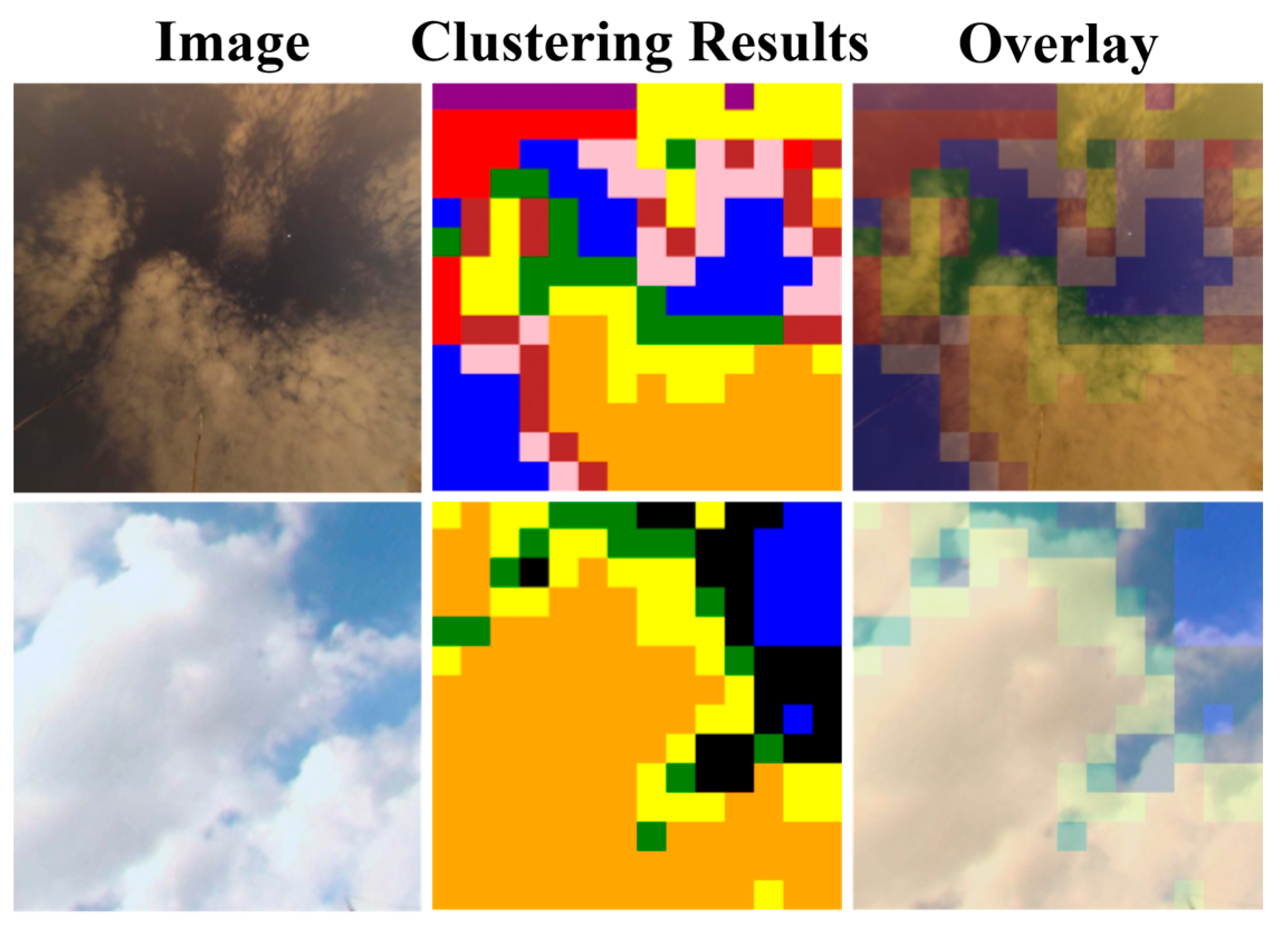
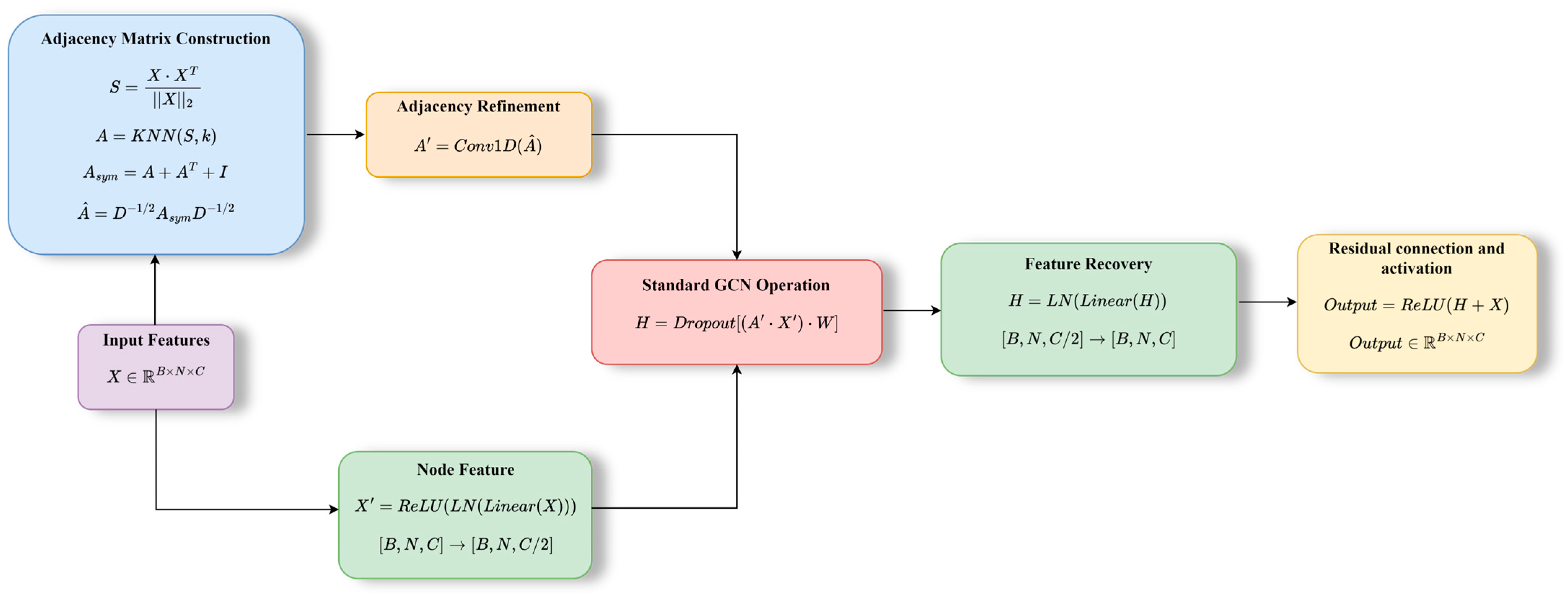
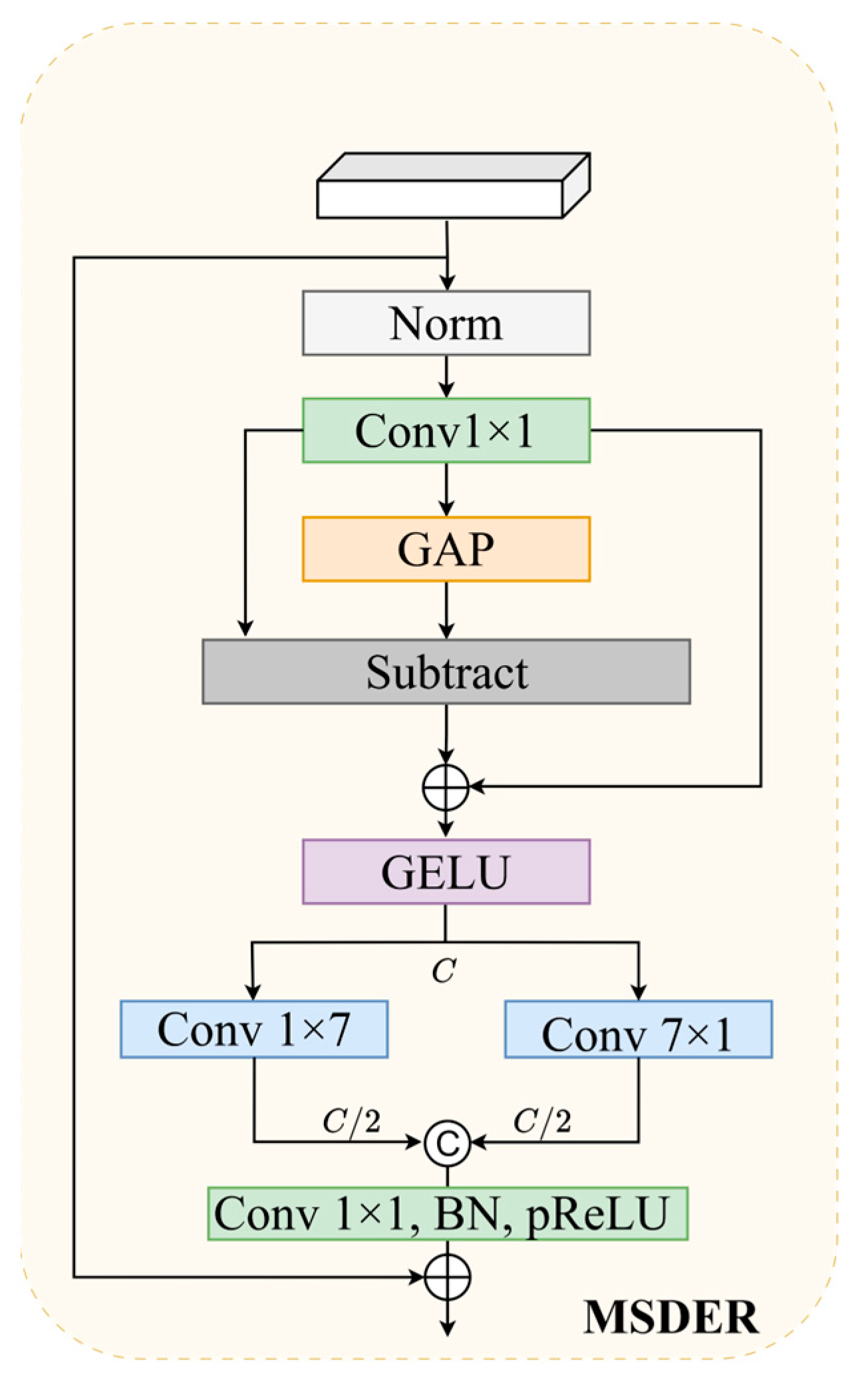
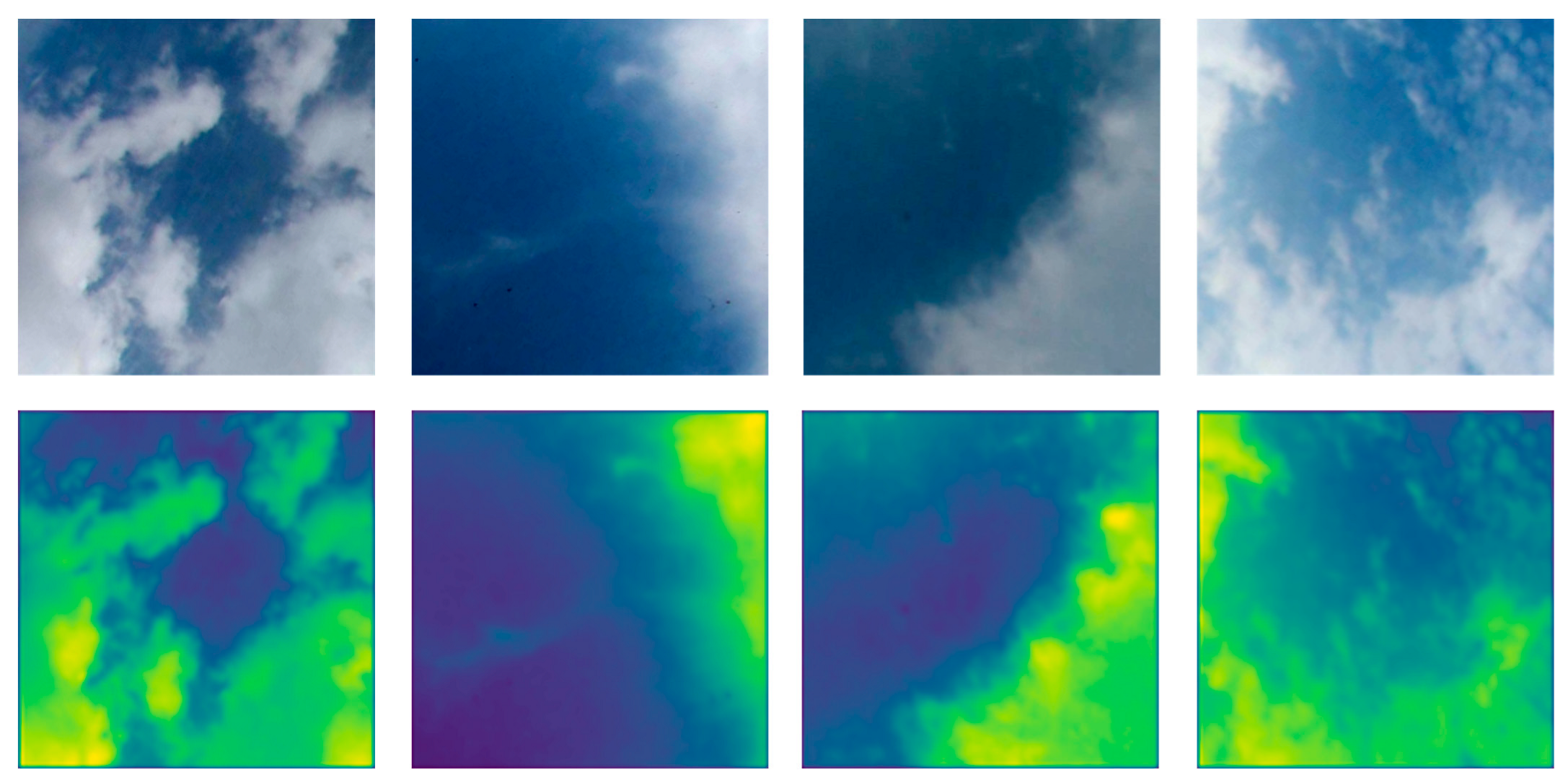
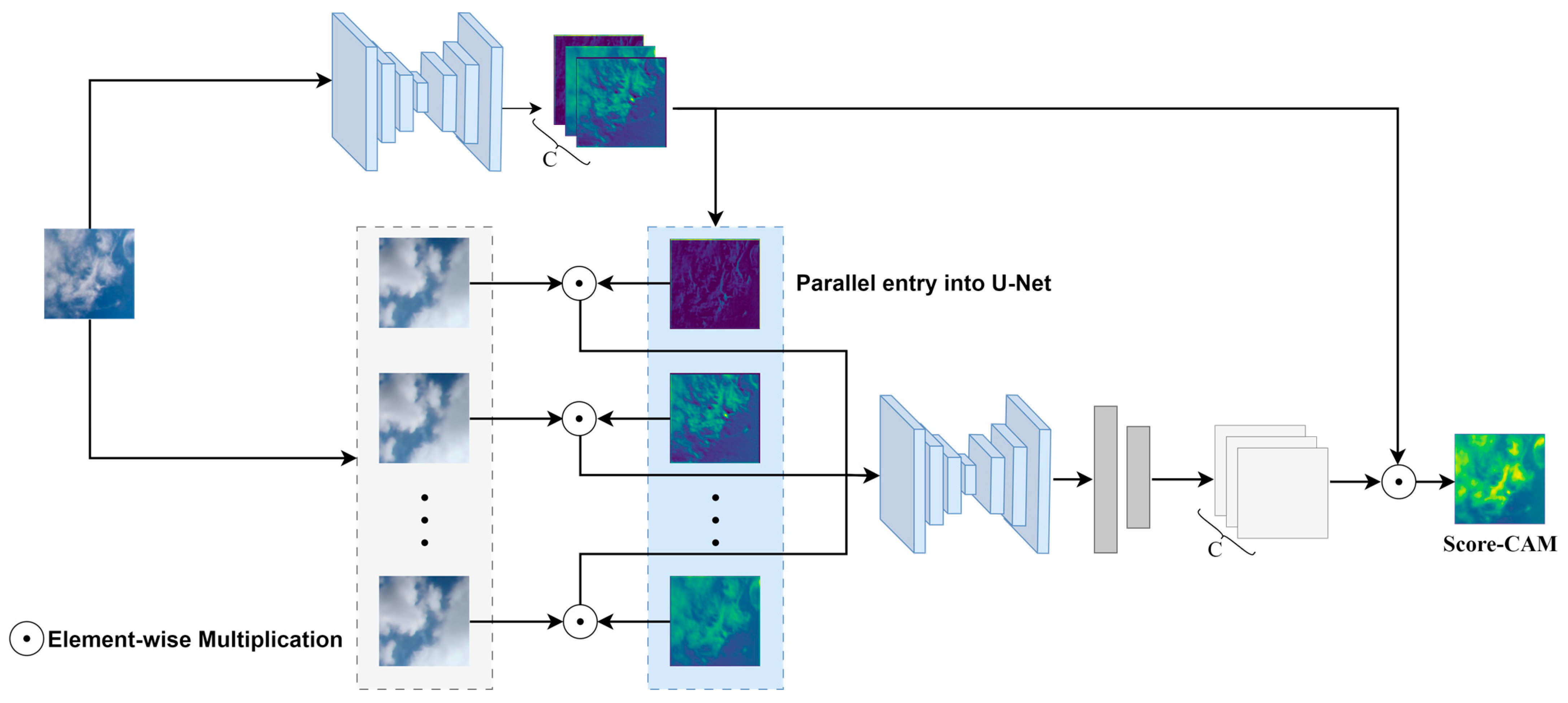
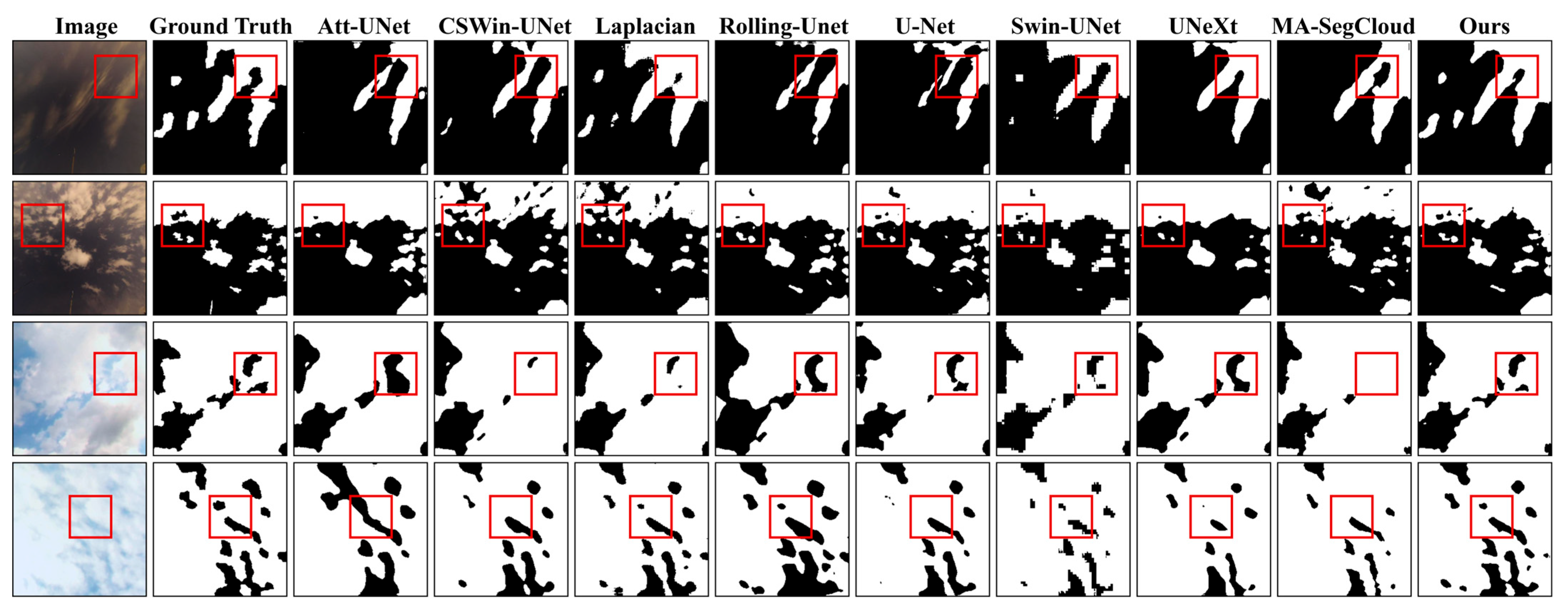
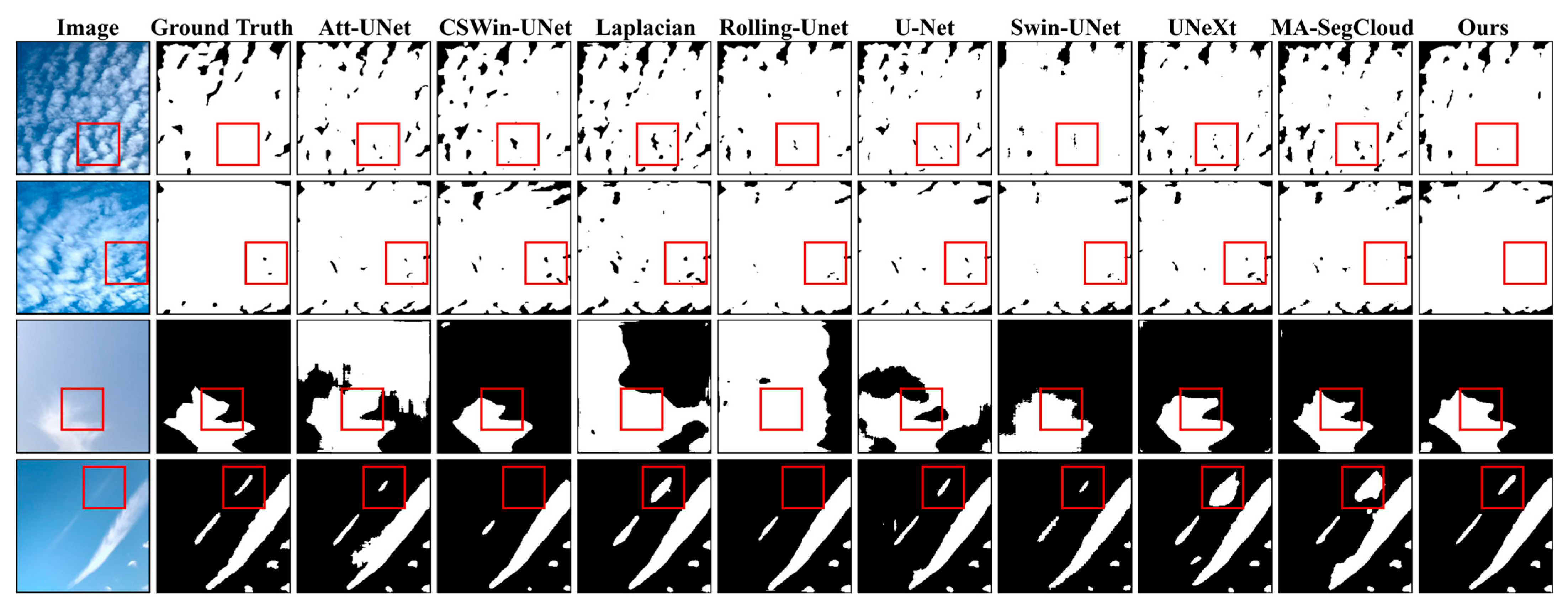
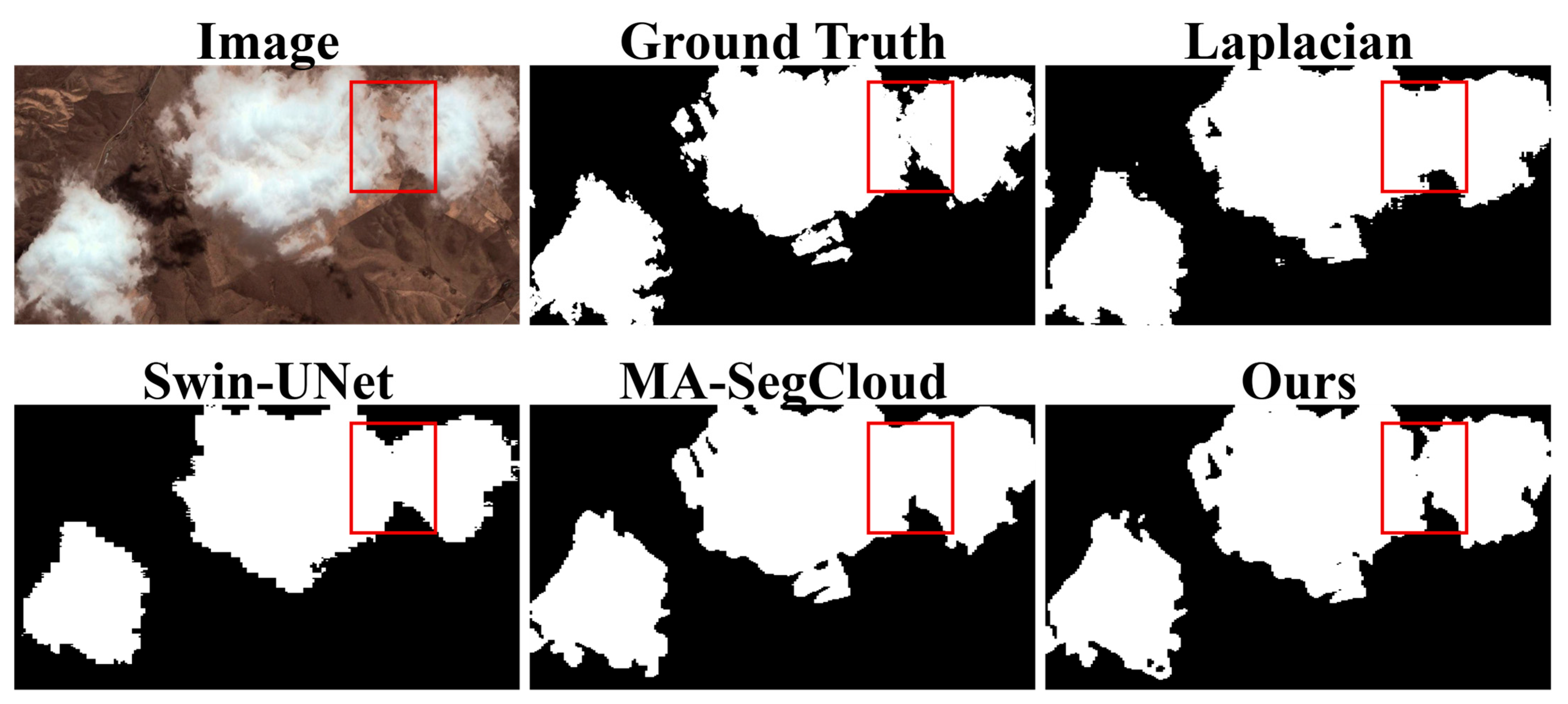
| Model | Param (M) | FLOPs (G) | GPU Inference Time (ms) |
|---|---|---|---|
| U-Net | 34.53 | 50.191 | 16.29 |
| Att-UNet | 34.88 | 50.98 | 17.09 |
| MA-SegCloud | 35.72 | 16.247 | 14.4 |
| Rollin-Unet (L) | 28.33 | 25.179 | 122.58 |
| Swin-UNet | 27.17 | 5.949 | 7.64 |
| Laplacian-Former | 25.33 | 4.97 | 27.77 |
| CSWin-UNet | 23.57 | 4.723 | 22.91 |
| UNeXt | 1.47 | 0.45 | 3.01 |
| Ours | 107.4 | 26.783 | 19.66 |
| Component | Parameter | Value | Description |
|---|---|---|---|
| PDAA | K (clusters) | 8 | Number of cluster centers |
| α (EMA decay) | 0.999 | Exponential moving average rate | |
| Group size (S) | 128 | Size of each attention group | |
| Iteration count | 3 | ||
| SAGCL | k (neighbors) | 64 | Number of nearest neighbors |
| Similarity metric | Cosine | Distance metric for graph construction | |
| MSDER | Kernel sizes | 1 × 7, 7 × 1 | Directional convolution kernels |
| UDLO | CAM | Calculate the frequency of CAM | |
| Training | λ (loss weight) | 0.5 | Balance between BCE and Dice loss |
| Learning rate | 0.0005 | Initial learning rate | |
| Batch size | 4 | Training batch size | |
| Input size | 224 × 224 | Input image dimensions |
| Type | Method | Recall ↑ | F1-Score ↑ | Error Rate ↓ | MIoU ↑ |
|---|---|---|---|---|---|
| Day | U-Net 2015 [19] | 85.67% | 88.85% | 8.53% | 81.92% |
| Att-UNet 2018 [20] | 87.23% | 89.66% | 8.17% | 82.91% | |
| Swin-Unet 2021 [22] | 88.82% | 90.70% | 7.60% | 84.40% | |
| Laplacian 2023 [23] | 89.37% | 90.67% | 7.58% | 84.50% | |
| MA-SegCloud 2022 [24] | 87.59% | 90.45% | 7.59% | 84.20% | |
| CSWin-UNet 2025 [25] | 88.05% | 90.82% | 7.82% | 84.52% | |
| Rolling-Unet 2024 [26] | 87.66% | 90.27% | 7.91% | 83.69% | |
| UNeXt 2022 [27] | 89.78% | 91.00% | 7.31% | 84.80% | |
| Ours | 93.08% | 92.56% | 6.07% | 87.32% | |
| Night | U-Net [19] | 78.00% | 82.13% | 12.82% | 71.96% |
| Att-UNet [20] | 78.74% | 83.67% | 12.65% | 73.65% | |
| Swin-Unet [22] | 85.87% | 85.80% | 11.27% | 76.72% | |
| Laplacian [23] | 76.69% | 83.39% | 12.56% | 73.62% | |
| MA-SegCloud [24] | 77.21% | 82.77% | 12.31% | 72.70% | |
| CSWin-UNet [25] | 71.26% | 80.57% | 13.16% | 70.06% | |
| Rolling-Unet [26] | 83.51% | 83.69% | 12.69% | 74.33% | |
| UNeXt [27] | 81.75% | 84.98% | 12.04% | 75.71% | |
| Ours | 86.76% | 88.02% | 10.01% | 79.62% | |
| Day + Night | U-Net [19] | 84.86% | 88.14% | 8.98% | 80.87% |
| Att-UNet [20] | 83.71% | 87.91% | 8.99% | 80.60% | |
| Swin-Unet [22] | 88.51% | 90.19% | 7.98% | 83.59% | |
| Laplacian [23] | 88.04% | 89.91% | 8.10% | 83.36% | |
| MA-SegCloud [24] | 86.23% | 89.55% | 8.22% | 82.85% | |
| CSWin-UNet [25] | 86.28% | 89.74% | 8.38% | 83.00% | |
| Rolling-Unet [26] | 87.22% | 89.58% | 8.41% | 82.71% | |
| UNeXt [27] | 88.93% | 90.36% | 7.81% | 83.84% | |
| Ours | 92.41% | 92.08% | 6.49% | 86.51% |
| Method | Recall ↑ | F1-Score ↑ | Error Rate ↓ | MIoU ↑ |
|---|---|---|---|---|
| U-Net [19] | 87.29% | 83.22% | 9.30% | 75.81% |
| Att-UNet [20] | 85.57% | 81.80% | 8.75% | 77.15% |
| Swin-Unet [22] | 85.96% | 82.87% | 8.96% | 75.12% |
| Laplacian [23] | 83.33% | 80.14% | 9.60% | 73.77% |
| MA-SegCloud [24] | 86.72% | 80.74% | 11.80% | 73.41% |
| CSWin-UNet [25] | 83.95% | 80.69% | 8.48% | 74.27% |
| Rolling-Unet [26] | 87.41% | 82.67% | 9.30% | 74.93% |
| UNeXt [27] | 85.15% | 80.96% | 8.66% | 75.17% |
| Ours | 87.41% | 82.47% | 7.98% | 78.77% |
| Method | Recall ↑ | F1-Score ↑ | Error Rate ↓ | MIoU ↑ |
|---|---|---|---|---|
| U-Net [19] | 88.59% | 91.36% | 6.06% | 84.36% |
| Att-UNet [20] | 89.65% | 91.90% | 5.71% | 85.34% |
| Swin-Unet [22] | 90.93% | 91.81% | 5.64% | 85.32% |
| Laplacian [23] | 83.39% | 84.98% | 9.98% | 75.23% |
| MA-SegCloud [24] | 90.49% | 91.95% | 5.68% | 85.34% |
| CSWin-UNet [25] | 89.12% | 92.23% | 5.23% | 85.88% |
| Rolling-Unet [26] | 88.26% | 90.38% | 6.73% | 82.91% |
| UNeXt [27] | 89.38% | 89.92% | 6.85% | 82.08% |
| Ours | 92.12% | 92.60% | 5.25% | 86.42% |
| Recall ↑ | F1-Score ↑ | Error Rate ↓ | MioU ↑ | |
|---|---|---|---|---|
| U-Net | 84.86% | 88.14% | 8.98% | 80.87% |
| U-Net + SAGCL | 93.81% | 90.68% | 8.03% | 84.12% |
| U-Net + PDAA | 88.54% | 90.04% | 8.17% | 84.12% |
| U-Net + MSDER | 84.57% | 89.09% | 8.66% | 82.13% |
| U-Net + SAGCL + PDAA | 89.46% | 91.28% | 7.26% | 85.20% |
| U-Net + SAGCL + PDAA + MSDER | 91.43% | 91.76% | 6.85% | 86.00% |
| U-Net + SAGCL + PDAA + MSDER + UDLO | 92.41% | 92.08% | 6.49% | 86.51% |
Disclaimer/Publisher’s Note: The statements, opinions and data contained in all publications are solely those of the individual author(s) and contributor(s) and not of MDPI and/or the editor(s). MDPI and/or the editor(s) disclaim responsibility for any injury to people or property resulting from any ideas, methods, instructions or products referred to in the content. |
© 2025 by the authors. Licensee MDPI, Basel, Switzerland. This article is an open access article distributed under the terms and conditions of the Creative Commons Attribution (CC BY) license (https://creativecommons.org/licenses/by/4.0/).
Share and Cite
Xu, Q.; Zhang, Z.; Wang, G.; Chen, Y. Graph-Symmetry Cognitive Learning for Multi-Scale Cloud Imaging: An Uncertainty-Quantified Geometric Paradigm via Hierarchical Graph Networks. Symmetry 2025, 17, 1477. https://doi.org/10.3390/sym17091477
Xu Q, Zhang Z, Wang G, Chen Y. Graph-Symmetry Cognitive Learning for Multi-Scale Cloud Imaging: An Uncertainty-Quantified Geometric Paradigm via Hierarchical Graph Networks. Symmetry. 2025; 17(9):1477. https://doi.org/10.3390/sym17091477
Chicago/Turabian StyleXu, Qing, Zichen Zhang, Guanfang Wang, and Yunjie Chen. 2025. "Graph-Symmetry Cognitive Learning for Multi-Scale Cloud Imaging: An Uncertainty-Quantified Geometric Paradigm via Hierarchical Graph Networks" Symmetry 17, no. 9: 1477. https://doi.org/10.3390/sym17091477
APA StyleXu, Q., Zhang, Z., Wang, G., & Chen, Y. (2025). Graph-Symmetry Cognitive Learning for Multi-Scale Cloud Imaging: An Uncertainty-Quantified Geometric Paradigm via Hierarchical Graph Networks. Symmetry, 17(9), 1477. https://doi.org/10.3390/sym17091477






